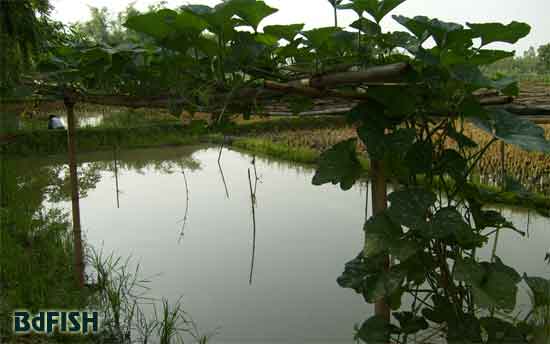
Background:
Adivasis are found far from the main stream development in Bangladesh. Unfortunately efforts neither on the proven aquaculture technology for ponds and rice fields nor the suitable approach like FFS (Farmers Field School) are taken for livelihood improvement of the more vulnerable Adivasi peoples. Therefore, the present study evaluated the performances of the FFS based poor adivasi households for fish culture in ponds and rice fields and studied their livelihood aspects in Northwest and Northern Bangladesh.
Objectives:
- To provide a strategy of using the multiple ownership ponds of the Adivasi people for fish culture;
- To build up methods with the help of the land owners to allow the lands to develop for rice fish culture by the Adivasi;
- To understand the technical issues related to the use of ponds and rice fields by Adivasi households and
- To study the changed livelihood assets and strategies of the Adivasi households involved in pond and rice field based fish culture under the project
Research Methodology:
The survey was conducted for a period of one year (September 2007 to August 2008) under 12 FFS in Pirganj of Rangpur district and Panchbibi of Joypurhat district, Bangladesh. The survey included 30 ponds (14 from Pirganj and 16 from Panchbibi), 42 rice fields (22 from Pirganj and 20 from Panchbibi) and 72 households (36 from each site). The households were selected through stratified random sampling. Other important activities included as presurvey visit, interview, and focus group discussions (FGD).
Strategy for using the multiple owned/leased ponds and rice plots:
Three different types of strategies or agreements (for a period of 1-3 years) between owner and operator were found to use the multiple owned or leased ponds and rice plots. Among the different strategies, maximum benefit was found for the resource poor Adivasis to use the leased rice fish plots.
| Multiple/ Leased ponds/plots | Labor sharing | Input sharing | Benefit/output sharing |
| Multiple owned ponds (One operator is selected only from the owners) | Operator will contribute 100% labor | Operator will provide 100% input cost | Operator will minus his total input cost from total production/income.Remaining production/income will be distributed equally among the owners |
| Multiple owned rice-fish plots | Owners will share equally | Owners will share equally | Owners will share equally |
| Leased rice-fish plots | Lease holder will provide all the labor | Lease holder will bear all the input cost | Production/income from rice will be distributed equally between land owner and lease holder.Lease holder will get the 100% of fish production/income. |
Fish culture technique:
Only polyculture of 2 to 9 species in Ponds and both monoculture and polyculture of 2 to 7 species in the rice field were found in the study area.
Performances of the households in the major technical issues to the use of ponds and rice fields:
Adivasi households were found well capable to demonstrate their minimum performances in maximum technical issues related to fish culture in ponds and rice fields.
| Technical issues | Pirganj, Rangpur | Panchbibi, Joypurhat | ||
| Pond (%) | Rice-Fish (%) | Pond (%) | Rice-fish (%) | |
| Pond preparation/ ditch excavation | 7.14 | 81.82 | 6.25 | 90 |
| Fish stocking | 78.57 | 100 | 100 | 85 |
| Supplementary feeding | 54.55 | 31.82 | 50 | 58.82 |
| Fertilization | 90.91 | 45.45 | 87.5 | 47.06 |
| Post stocking lime and ash application | – | – | 25 | – |
| Vegetable production on dyke | 14.29 | 13.64 | 18.75 | 15.0 |


Fish production and economics:
Mean fish production in ponds and rice fields varied from 1196.71 ±805.01 kgha-1 (Pirganj) to 1246.38± 1249.14 kgha-1 (Panchbibi) and 283.12±384.63 kgha-1 (Panchbibi) 296.68±404.03 kgha-1 (Pirganj) respectively. In case of multi owned ponds, the number of owner/share varied from 2 to 3 and the profit per share was found to decrease with the increase in share. Single owned rice fields were found better than that of the multiple owned or leased in terms of production and profit. Leased rice fields were found better than that of the multiple owned.
Changed livelihoods:
Although the production was not found high enough in most cases, but due to the present effort for fish culture in ponds and rice-fields, fish consumption and income were increased in the study areas.
Mean rice production varied from 4771.12±1290.28 kgha-1 (Panchbibi) to 5449.95±862.39 kgha-1 (Pirganj). Increased production was reported by 38.89% households in Pirganj and 31.25% households in Panchbibi. Dykes of ponds (14.29% in Pirganj and 18.75% in Panchbibi) and rice fields (13.64% in Pirganj and 15.0% in Panchbibi) were also used for vegetable production and thereby vegetable consumption increased as 30.56% in Pirganj and as 52.78% in Panchbibi. Fish culture in ponds and rice-fields increased the fish consumption from 13.89% to 16.67% and income as 16.67%. Poor Adivasi households (97.22% to 100%) agreed to continue fish culture in the study areas indicated that they found the present effort as an effective option for the improvement in livelihood.
Increasing the institutional support through strengthening the FFS can be an important strategy to improve the Adivasi livelihood through fish culture. Formal as well as long term agreements between owner and operator may have potentials for the poor Adivasi households to use the multiple owned or leased ponds and rice fields.
Acknowledgements:
Shams Muhammad Galib, Md. Mehedi Hasan and Angkur Md. Imteazzaman
Visited 2,115 times, 1 visits today | Have any fisheries relevant question?
